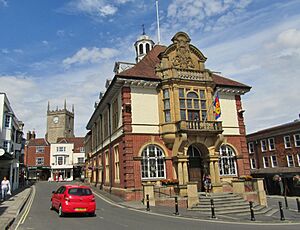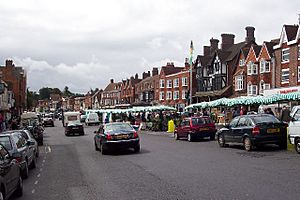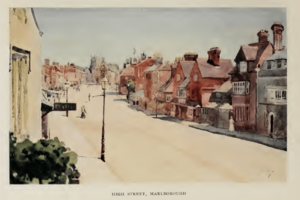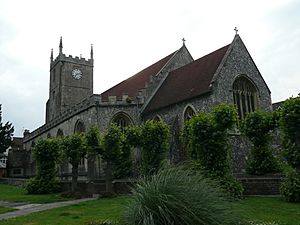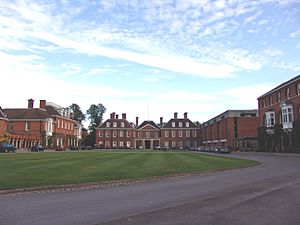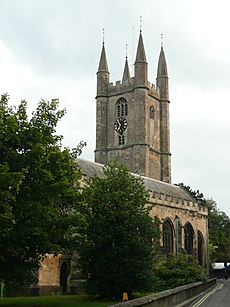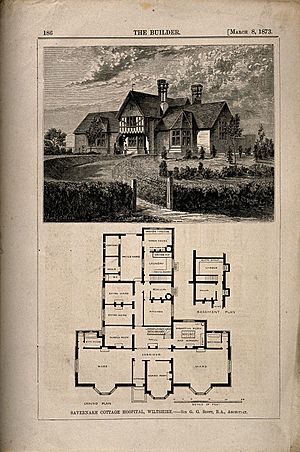Marlborough, Wiltshire facts for kids
Quick facts for kids Marlborough |
|
|---|---|
 High Street |
|
| Population | 9,129 (2021 Census) |
| OS grid reference | SU1969 |
| Civil parish |
|
| Unitary authority |
|
| Ceremonial county | |
| Region | |
| Country | England |
| Sovereign state | United Kingdom |
| Post town | Marlborough |
| Postcode district | SN8 |
| Dialling code | 01672 |
| Police | Wiltshire |
| Fire | Wiltshire |
| Ambulance | Great Western |
| EU Parliament | South West England |
| UK Parliament |
|
Marlborough (pronounced MAWL-bər-ə) is a historic market town in the Wiltshire county of England. It sits on the River Kennet, which is 24 miles (39 km) north of Salisbury. The town is also 10 miles (16 km) southeast of Swindon. Marlborough is located on the old main road from London to Bath.
Contents
History of Marlborough
The oldest sign of people living here is the Marlborough Mound. This is a large, 62 feet (19 m)-high hill found at Marlborough College. Scientists have used radiocarbon dating to find out it was built around 2400 BC. This makes it about the same age as the famous Silbury Hill, which is about 5 miles (8.0 km) west of the town.
Legend says that the Marlborough Mound is where the wizard Merlin is buried. Some believe the town's name comes from "Merlin's Barrow" (barrow means a burial mound). A more likely idea is that the name comes from "marl," which is a type of chalky ground. So, it could mean "town on chalk."
However, some research suggests the name Merleberge comes from a person named Mærle and beorg (hill). Or it could mean "hill where gentian flowers grow." On an old map from 1611, the town was called Marlinges boroe. The town's motto is Latin for "Where now are the bones of wise Merlin."
Archaeologists also found the Marlborough Bucket in St Margaret's Mead. This Iron Age bucket was used for burials. It was made of fir wood with iron and bronze decorations. You can see it today at the Wiltshire Museum in Devizes.
Roman remains have been found two miles east of Marlborough, at Mildenhall. A large collection of Roman coins, called the Cunetio Hoard, was also discovered there. Later, a Saxon village grew up around The Green.
Marlborough Castle and Royal Connections
In 1067, William the Conqueror took control of the Marlborough area. He built a wooden motte-and-bailey castle on top of the ancient mound. This castle was finished around 1100. Around 1175, stone was used to make the castle stronger. The first written mention of Marlborough is in the Domesday Book from 1086. William also set up a mint in Marlborough. Here, silver coins were made for William I and early William II.
William the Conqueror also made the nearby Savernake Forest a royal hunting ground. Marlborough Castle became a place where kings and queens lived. Henry I spent Easter here in 1110. Henry II met with the King of Scotland at Marlborough Castle. His son, Richard I (known as "Coeur de Lion"), gave the castle to his brother John in 1186. King John was married here and spent time in Marlborough. He also set up a Treasury in the town.
In 1204, King John gave Marlborough a special Charter. This allowed the town to hold an annual eight-day fair starting on August 14th. It also allowed weekly markets on Wednesdays and Saturdays, which still happen today.
In 1267, Henry III held Parliament in Marlborough. During this time, the Statute of Marlborough was passed. This law gave rights to small landowners and limited the King's power to take land. It is one of the oldest laws in English law that is still in effect today.
A Jewish community lived in Marlborough from the 1230s near Silver Street. They had a synagogue. In 1275, the Queen, Eleanor of Provence, made Jews leave all towns she owned. So, the Jews of Marlborough moved to Devizes.
The castle slowly fell apart by the end of the 14th century. It remained property of the Crown. Later, Edward VI gave it to the Seymour family, who were his mother's relatives. In 1498, Thomas Wolsey became a priest in St Peter's church. He later became a powerful cardinal and Lord Chancellor.
English Civil War and Great Fires
In 1642, the English Civil War began. The Seymours supported the King at the Castle, but the town supported Parliament. King Charles sent troops to take Marlborough. The town was known for being against the King.
On November 24, 1642, Lord Digby led 400 horsemen to take the town. He tried to talk to the townspeople first, which gave them time to prepare. They gathered about 700 poorly armed men. The town refused to surrender, saying they would rather die than give up to a "traitor" like Lord Digby.
After some fighting, Royalist troops entered the town through small alleys. Marlborough was captured, looted, and many buildings were burned. One hundred and twenty prisoners were marched to Oxford. The King later left the town, and it did not play a big part in the rest of the war.
On April 28, 1653, the Great Fire of Marlborough started in a tanner's yard. It quickly spread and burned for four hours. The fire destroyed the Guildhall, St Mary's Church, the County Armoury, and 244 houses. People from other towns even collected money to help the people of Marlborough.
When the town was rebuilt after this fire, the high street was made much wider. Some say it is the widest high street in England, though Stockton-on-Tees claims to have the widest. This wide street provides plenty of space for the local market. Fires swept through the town again in 1679 and 1690. After these fires, a special law was passed. It made it illegal to cover houses and other buildings with thatch (straw roofs) in Marlborough.
In 1804, the Marlborough White Horse was carved into a hillside southwest of the town. Boys from Mr Greasley's Academy in the High Street created it.
In 1901 and 1934, the town's boundaries grew to include the small village of Manton and part of Preshute. Marlborough Town Hall was finished in 1902.
In 2004, Marlborough celebrated 800 years since it received its Town Charter. The celebrations included a play and a visit from the Prince of Wales.
Events in Marlborough
The Marlborough mop fair used to be a market where goods were traded. Later, it became a hiring fair for farm workers looking for jobs. Today, it is a fun travelling funfair. It happens over two weekends in October, known as the "big mop" and "little mop" fairs.
From 1986, Marlborough hosted a music festival in June or July. In 1997, it became the Marlborough International Jazz Festival. This festival stopped after 2016.
Notable Buildings
The parish church of St Mary is a Grade I listed building. This means it is a very important historic building.
St George's church in Preshute, next to Manton, was built in the 12th century. It was largely rebuilt in 1854. It is a Grade II* listed building.
The Church of St Peter and St Paul is at the west end of the High Street. It is also a Grade II* listed building. It dates from the 15th century and was partly rebuilt in 1862–63. Cardinal Wolsey became a priest here in 1498.
On the north side of the high street is the Merchant's House. This house is being restored, but parts of it are open for tours. It was built after the Great Fire of 1653. It belonged to a silk merchant. What makes it special are the original wall paintings that have been found. One room is painted with a striped pattern, like silk hangings, which is very rare in Great Britain.
Governance
Marlborough is part of Wiltshire county. It is managed by the Wiltshire Council, which is a single authority for local government. The town has two areas for elections, called wards: Marlborough East and Marlborough West.
Marlborough and Manton together form a civil parish. This parish has a council called the Marlborough Town Council, with 16 councillors.
For elections to Wiltshire Council, Marlborough is covered by two electoral divisions, Marlborough East and Marlborough West. Each division elects one member. These divisions also include areas outside the town.
Marlborough was part of the Devizes constituency until 2024. Now, it is in the new East Wiltshire constituency. Since 2019, its representative in the House of Commons (the UK Parliament) has been Danny Kruger, who is a Conservative. The town has had a Conservative representative since 1924.
Education
Marlborough College is a private boarding school located on the west side of town.
The main public secondary school in town is St John's Academy. It is known for being an excellent school and sixth form college. In 2014, it was rated "outstanding." St John's was formed when the old Marlborough Grammar School and secondary modern school joined together. There is also a primary school called St Mary's.
Sport
Marlborough is home to Marlborough Rugby Club. In 2009–10, they had a very successful season, winning all 22 games and moving up to a higher league. In 2023, they won their league and were promoted to tier 5 for the first time. The club has a second senior team and many younger players.
Marlborough Town F.C. plays its home games at Elcot Lane, east of the town. They are part of the Wiltshire Football League. There is also a youth football club, Marlborough Youth FC, with over 350 players. They play in the North Wiltshire Youth Football League.
Marlborough also has a cricket team. Its top team plays in the WEPL Wiltshire Premier Division. Marlborough Hockey Club plays at Marlborough College. A parkrun (a free, weekly 5k running event) takes place on Marlborough Common every Saturday.
Religion
Marlborough is an important part of the Church of England Marlborough deanery. This area is within the diocese of Salisbury. Of the town's two Church of England parish churches, St Peter's is no longer used for worship. It has been turned into an arts centre. St Mary's, a Grade I listed building, is still used for church services.
The famous jockey Sir Gordon Richards is buried in the new cemetery on Marlborough Common.
Media
Local TV services for Marlborough come from BBC West and ITV West Country. You can listen to BBC Radio Wiltshire on 104.9 FM and Heart West on 96.5 FM. The local newspaper for the area is the Gazette and Herald.
Transport
Marlborough used to have two railway lines, but it no longer has direct train access. The closest train stations are Pewsey (6.7 miles), Bedwyn (6.9 miles), and Swindon (12.7 miles).
Marlborough is well-connected by roads. The A4 (from Hungerford to Calne), the A346 (from Tidworth to Swindon), and the A345 (from Salisbury) all meet here.
The long-distance walking path, the Wessex Ridgeway, starts in Marlborough and goes all the way to Lyme Regis in Dorset.
Notable People
Many interesting people have connections to Marlborough:
- Brett Angell, a former footballer.
- Bo Bruce, a singer.
- David Brudenell-Bruce, Earl of Cardigan, who is the 31st hereditary warden of Savernake Forest.
- Nick Drake, a folk singer and guitarist. He went to school here, and his letters to his parents are in a book called "Remembered For A While." His father and grandfather also went to the same school.
- William Golding, who won the Nobel Prize and wrote Lord of the Flies. He grew up in Marlborough.
- Charles Hancock, a painter.
- Thomas Hancock, an inventor and engineer.
- Walter Hancock, an inventor of steam-powered road vehicles.
- Phil Harding, an archaeologist from the TV show Time Team. He was educated in Marlborough.
- John Ivimey (1868–1961), an organist and composer who lived in Marlborough.
- Eglantyne Jebb, who founded Save the Children Fund. She taught at St. Peter's Junior School, which is now the Town Library.
- Leonard Jennings, a first-class cricketer and Royal Air Force officer.
- Phillip Sheppard, a geneticist.
- Edward Thompson, a chief mechanical engineer for a railway company.
Twin Towns
Marlborough is twinned with two other towns:
- Gunjur, the Gambia, since 1982.
- Margency, France, since 2002.
Climate
Marlborough has an oceanic climate, which means it has mild temperatures. Because it is inland and 407 feet (124 m) high up, it can get more frost than places closer to the coast. For example, in 1909, Marlborough recorded one of the lowest temperatures in the UK for that year, reaching −17.8 °C (0.0 °F) on March 3rd.
| Climate data for Marlborough (1991–2020) | |||||||||||||
|---|---|---|---|---|---|---|---|---|---|---|---|---|---|
| Month | Jan | Feb | Mar | Apr | May | Jun | Jul | Aug | Sep | Oct | Nov | Dec | Year |
| Mean daily maximum °C (°F) | 7.5 (45.5) |
8.1 (46.6) |
10.8 (51.4) |
13.7 (56.7) |
16.9 (62.4) |
19.6 (67.3) |
21.7 (71.1) |
21.6 (70.9) |
18.7 (65.7) |
14.4 (57.9) |
10.7 (51.3) |
8.0 (46.4) |
14.3 (57.7) |
| Mean daily minimum °C (°F) | 1.4 (34.5) |
1.2 (34.2) |
2.5 (36.5) |
3.9 (39.0) |
6.3 (43.3) |
9.2 (48.6) |
11.3 (52.3) |
11.1 (52.0) |
8.7 (47.7) |
6.5 (43.7) |
3.6 (38.5) |
1.4 (34.5) |
5.6 (42.1) |
| Average rainfall mm (inches) | 86.9 (3.42) |
60.3 (2.37) |
57.5 (2.26) |
58.4 (2.30) |
57.4 (2.26) |
55.6 (2.19) |
65.3 (2.57) |
68.3 (2.69) |
60.7 (2.39) |
88.6 (3.49) |
91.9 (3.62) |
89.4 (3.52) |
840.9 (33.11) |
| Average rainy days (≥ 1 mm) | 13.0 | 10.9 | 10.1 | 10.2 | 9.8 | 9.2 | 9.5 | 10.8 | 9.5 | 12.0 | 13.5 | 13.0 | 132.0 |
| Mean monthly sunshine hours | 53.4 | 74.8 | 114.9 | 169.4 | 197.4 | 193.8 | 209.9 | 185.3 | 149.7 | 101.8 | 63.3 | 49.2 | 1,563.3 |
| Source: Met Office | |||||||||||||
Images for kids
See also
 In Spanish: Marlborough (Wiltshire) para niños
In Spanish: Marlborough (Wiltshire) para niños



